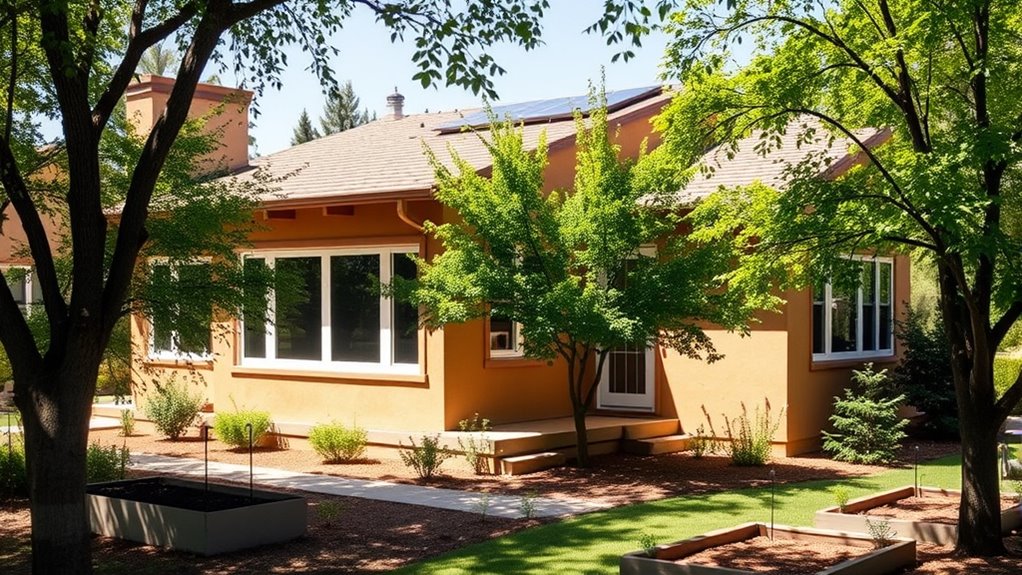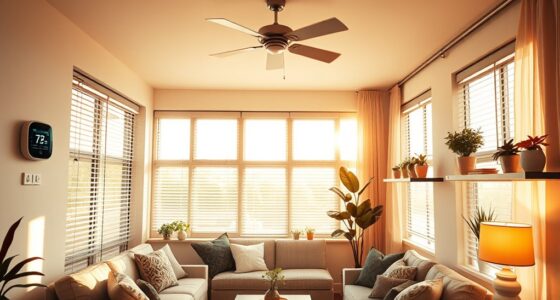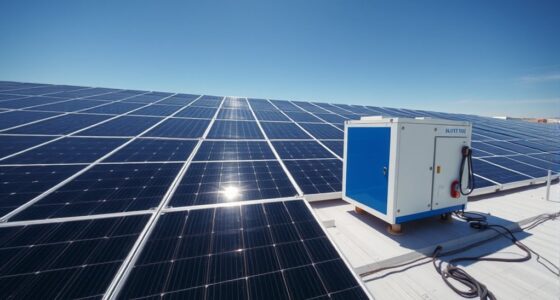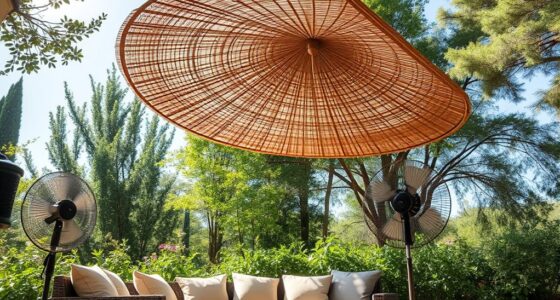Designing passive solar homes for seniors involves maximizing natural sunlight and warmth while minimizing energy costs. You should position large south-facing windows, use thermal mass like concrete or brick to store heat, and add shading devices such as overhangs or trees to block summer sun. Combining these features with good insulation creates a cozy, energy-efficient environment. Keep exploring the principles behind these strategies to enhance comfort and sustainability in your home design.
Key Takeaways
- Orient living spaces southward to maximize sunlight exposure during winter months.
- Incorporate adjustable shading devices like overhangs or awnings to control summer heat gain.
- Use thermal mass materials such as concrete or brick to absorb and slowly release heat for stability.
- Minimize north-facing windows to reduce heat loss and improve overall energy efficiency.
- Combine passive solar design with effective insulation and airtight construction for optimal comfort and savings.
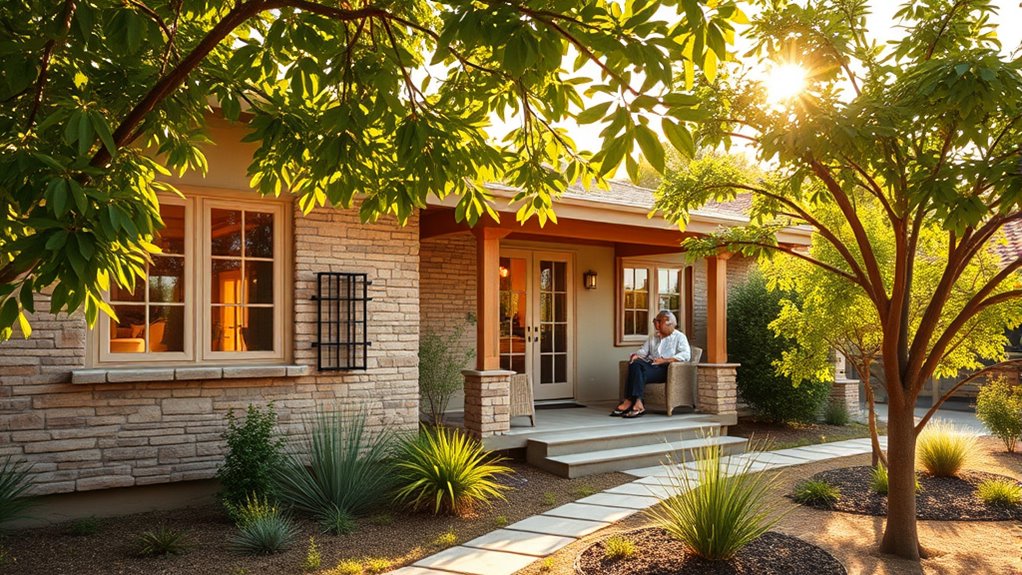
As seniors seek ways to stay comfortable and reduce energy costs, passive solar homes offer an effective solution. These homes are designed to harness natural sunlight and heat, making everyday living more comfortable while lowering utility bills. One of the key features in designing these homes is solar shading. Proper solar shading helps control the amount of sunlight entering the home, preventing overheating during warm months and allowing for more sunlight in winter. You might use adjustable awnings, overhangs, or shading devices that block high summer sun but let in lower winter rays. This strategic shading minimizes the need for air conditioning and reduces heat loss, creating a cozy environment year-round.
Proper solar shading reduces overheating in summer and boosts winter sunlight, enhancing energy efficiency all year round.
Along with solar shading, thermal mass plays a vital role in passive solar design. Thermal mass refers to materials that absorb, store, and slowly release heat. When you incorporate materials like concrete, brick, or stone into your home’s floors or walls, you create a natural buffer against temperature fluctuations. During the day, these materials soak up excess heat from sunlight, preventing indoor temperatures from rising too high. As the sun sets, they gradually release that stored heat, keeping your living space warm and comfortable through the night. This process reduces reliance on heating systems, saving energy and money while maintaining a stable indoor climate.
Designing a passive solar home with attention to solar shading and thermal mass means you can enjoy a more energy-efficient space that adapts to seasonal changes. For example, large south-facing windows can maximize sunlight in winter but need to be shaded in summer. Overhangs or deciduous trees can provide that shade when the sun is high, preventing overheating. Meanwhile, thermal mass materials should be placed where they can absorb sunlight effectively, such as floors or interior walls facing the sun. This thoughtful placement ensures your home benefits from natural heat regulation, making it more comfortable and easier to maintain.
Additionally, understanding the passive solar principles behind these features can help you optimize your home’s design for maximum efficiency and comfort. You also want to consider the overall layout to optimize these features. Positioning living spaces on the south side allows maximum sunlight exposure, while minimizing windows on the north side reduces heat loss. Proper insulation and airtight construction complement these passive features, further enhancing your home’s energy efficiency. By combining solar shading and thermal mass with good design principles, you can create a passive solar home tailored to your needs, offering comfort, savings, and sustainability. It’s a smart way to make your home more adaptable to seasonal changes and more enjoyable to live in as you age.
Frequently Asked Questions
What Type of Insulation Is Best for Passive Solar Homes?
You should choose high-quality insulation materials like spray foam or cellulose to maximize thermal efficiency in passive solar homes. These insulation options provide excellent R-values, helping you retain heat during winter and stay cool in summer. By selecting the right insulation, you improve energy efficiency and comfort, ensuring your home stays warm and cozy with less energy use. Prioritizing thermal efficiency with suitable insulation materials is key to a sustainable, comfortable passive solar home.
How Does Landscaping Impact Solar Heat Gain?
Did you know that proper landscaping can reduce cooling costs by up to 20%? Landscaping strategies and shading techniques profoundly impact solar heat gain by blocking unwanted sunlight and diverting wind, helping your home stay cooler in summer and warmer in winter. Planting deciduous trees near windows provides shade during hot months while allowing sunlight in winter. Thoughtful landscaping enhances passive solar design, making your home more energy-efficient and comfortable year-round.
Are There Specific Window Treatments Recommended for Seniors?
You should choose window coverings that offer easy light control, like motorized shades or cordless blinds, for seniors. These options allow simple adjustments to control glare and heat, enhancing comfort and safety. Light control is essential to prevent eye strain and regulate indoor temperature. Opt for treatments that are easy to operate, maintain, and provide flexibility, ensuring seniors can manage their space comfortably without difficulty.
What Maintenance Is Required for Passive Solar Heating Systems?
Think of your passive solar heating system as a well-tuned orchestra; routine maintenance keeps it performing smoothly. You should regularly check and clean vents, filters, and movable insulation to prevent dust buildup. Inspect for leaks or damage, and ensure the glass is spotless for maximum sunlight. Following these maintenance tips boosts system longevity, saves energy, and keeps your home warm and comfortable year-round. Regular upkeep is the key to a harmonious, efficient system.
How Can Passive Solar Design Accommodate Mobility Challenges?
You can make passive solar homes more mobility-friendly by incorporating mobility-friendly layouts that reduce the need for long walks or stairs. Guarantee accessible entryways are wide and step-free, making it easier for wheelchairs or walkers. Use large, unobstructed pathways and strategically placed windows for natural light, so seniors can navigate safely and comfortably. These features enhance independence and safety, creating a warm, welcoming environment tailored to mobility challenges.
Conclusion
Designing passive solar homes for seniors is like planting seeds for a brighter, more comfortable future. By harnessing natural sunlight and thoughtful design, you create a space that feels warm and welcoming—almost like a hug from the sun itself. These homes not only save energy but also support your independence and well-being. Embrace this approach, and you’ll build a sanctuary that nurtures your comfort and vigor, just like a gentle sunrise after a long night.
